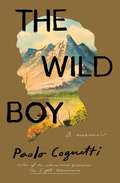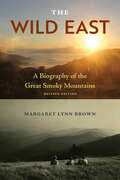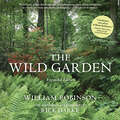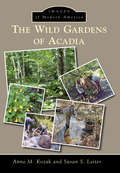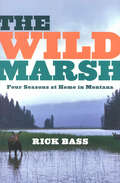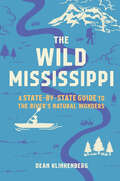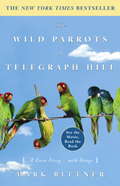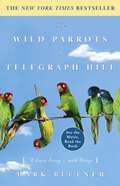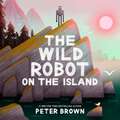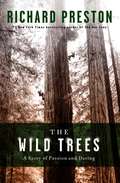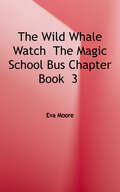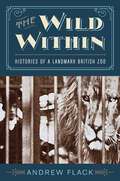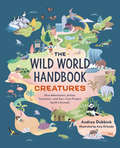- Table View
- List View
The Wild Boy: A Memoir
by Paolo CognettiA young man escapes his painful past by retreating to the rustic comfort of the Italian Alps in this gorgeously wrought memoir from the internationally bestselling author of the “exquisite” (Annie Proulx) novel The Eight Mountains.When life in the city becomes too overwhelming for Paolo, he decides to take refuge high in the Italian mountains. Returning to the breathtaking Valle d’Aosta—known for its snowcapped mountain peaks—after a decade’s absence, he rediscovers a simpler life and develops deep human connections with two neighbors. In this stunning landscape, he begins to take stock of his life and consider what he truly values. With lyrical and evocative prose, The Wild Boy is a testament to the power of the natural world, the necessity of an ever-questioning mind, and the resilience of the human spirit.
The Wild Bunch
by Jan GangseiThree unlikely friends—brainiac Hector, bullish Jack, and sarcastic Paul—find themselves braving the wilderness in search of the mythical Beast of Bear Falls in this hilarious MAX novel.As far as Paul Adams is concerned, the idea of a weekend camping in the nearby state park with his dad’s two college friends and their sons, Hector and Jack, sounds like a nightmare. But even he finds the myth of the Beast of Bear Falls—a legendary Bigfoot creature—intriguing. The trip gets off to a rough start, and calamity and disaster follow catastrophe. Against all odds, arguing most of the way, the crew face all sorts of obstacles natural and man-made. Can the three boys make it to Bear Falls and uncover the truth about the Sasquatch living there?
The Wild East: A Biography of the Great Smoky Mountains
by Margaret Lynn BrownThe classic environmental history of the Great Smoky Mountains, updated with a view from the twenty-first century The Wild East explores the social, political, and environmental changes in the Great Smoky Mountains during the nineteenth and twentieth centuries. Although this national park is most often portrayed as a triumph of wilderness preservation, Margaret Lynn Brown concludes that the largest forested region in the eastern United States is actually a re-created wilderness—a product of restoration and even manipulation of the land. Several hundred years before white settlement, Cherokees farmed and hunted this land. Between 1910 and 1920, corporate lumbermen built railroads into the region’s most remote watersheds and removed more than 60 percent of the old-growth forest. Despite this level of human impact, those who promoted the establishment of a national park in 1934 represented the land as an untouched wilderness and described the people living there as pioneers. Toward the end of the twentieth century, Brown writes, the Smokies faced the consequences of decades of management decisions that fluctuated between promoting human tourism and ensuring environmental preservation. Nearly 25 years after the book’s first publication, this revised edition discusses current research, citizen science initiatives, and land management practices that are restoring native plants and wildlife populations in the twenty-first century. Margaret Lynn Brown emphasizes the extraordinary treasure that is the Great Smoky Mountains and the importance of continuing to invest in the park’s protection for years to come.
The Wild Game Cookbook: Simple and Delicious Ways to Prepare Venison, Waterfowl, Fish, Turkey, and Small Game
by Kate FiducciaGetting away from it all doesn’t have to include letting hunger spoil your adventure—not with Kate Fiduccia’s guide to preparing hearty meals and delicious snacks for every trail you traverse. The Wild Game Cookbook contains more than 150 easy recipes that can be cooked over a campfire, on a woodstove, or on the grill. All of these game recipes use basic ingredients and require short cooking times. After all, when you’re in the outdoors, who wants to spend hours preparing complicated meals?Readers will find mouth-watering recipes for both fish and wild game, including: Beer Batter PerchRainy Day Venison ChiliBorder-Style Scrambled EggsSkillet BreadOutback HashbrownsGrilled Camp VeggiesWild Blueberry CobblerIn-the-Wild PopcornWild Mint Iced TeaAnd much more!The Wild Game Cookbook also features some of Kate’s latest and greatest jerky recipes. Take the book with you on your next outdoor adventure and see for yourself just how tasty trail life can be.
The Wild Garden: Expanded Edition
by William Robinson Rick DarkeFirst published in 1870, The Wild Garden challenged the prevailing garden style of the day and advocated a naturalistic style, in which hardy plants, both native and exotic, are arranged in groupings that mimic wild landscapes. Thanks to Robinson’s passionate advocacy, the naturalistic style triumphed, and Robinson's urgent message continues to resonate today. For this newly designed edition, Rick Darke has written an introductory essay that not only underscores Robinson’s importance in the evolution of garden design and ecology, but also explains his relevance for today’s gardeners, designers, and landscape professionals. The book contains over 100 stunning photographs taken by Darke, including images of Gravetye and of modern “wild” gardens.
The Wild Gardens of Acadia (Images of Modern America)
by Anne M. Kozak Susan S. LeiterFounded in 1961 at Sieur de Monts Spring in Maine's Acadia National Park, the Wild Gardens of Acadia display, preserve, propagate, and label native plants in areas simulating natural plant communities. The gardens, which originated from a competition in growing native plants sponsored by the Bar Harbor Garden Club, continue to be developed and maintained by volunteers in partnership with Friends of Acadia and Acadia National Park. Each of the gardens' 13 habitats, ranging from mountain to beach to bog to deciduous and coniferous woods, displays plants native to the park. Since the founding, countless park visitors have come to the gardens to identify plants they have seen on walks or hikes or to learn more about cultivating native plants. Many of the images in this book are drawn from the extensive photograph collection of the Wild Gardens of Acadia.
The Wild God of the World: An Anthology of Robinson Jeffers
by Robinson Jeffers&“The forgotten giant of American poetry . . . For those who would discover Jeffers . . . this is the place to start—and a place to return again and again.&” —Tim Hunt, Washington State University Robinson Jeffers (1887-1962) is not only the greatest poet that the American West has produced but also a major poet of the twentieth century in the tradition of American prophetic poetry. This anthology serves as an introduction to Jeffers&’s work for the general reader and for students in courses on American poetry. Jeffers composed each volume of his verse around one or two long narrative or dramatic poems. The Wild God of the World follows this practice: in it, Cawdor, one of Jeffers&’s most powerful narratives, is surrounded by a representative selection of shorter poems. At the end of the book, the editor has provided revealing statements about Jeffers&’s poetry and poetics, and about his philosophy of nature and human nature. &“Of all the poets of his generation, [Robinson Jeffers] made our relation to this earth and sea and sky and wheeling seasons and the evolutionary processes that made trees and salmon runs and hunting hawks, his subject. As that relation grows more troubled, his words become more necessary. To have this beautifully edited and freshly seen anthology is a gift.&” —Robert Hass, University of California, Berkeley
The Wild Horse Effect: Awe, Well-Being, and the Transformative Power of Nature
by Chad HansonCombining stunning imagery with insights from the new science of awe and contemplative practices, The Wild Horse Effect reminds us that stepping away from our modern lives and reconnecting with the natural world is essential to our sense of peace, purpose, and well-being.This unique nature book invites you into a world seldom experienced by humans through breathtaking imagery of wild horses on the open plains. In addition, author Chad Hanson delves into current research and lays out the myriad mind-body benefits of spending time in natural spaces. "Try this" sidebars throughout offer simple ways to get outside, practice mindfulness, and discover more wonder in your every day, no matter where you live. Handsomely designed to evoke the allure of the West and brimming with images that range from austere to heartwarming to jubilant, this transporting book will appeal to animal and nature lovers, photography enthusiasts, and anyone interested in improving their well-being through time spent outdoors.STEP INTO NATURE: Through beautiful photography of sprawling landscapes, dusky skies, wild mustangs, and galloping stallions, this book invites readers to get lost in its pages and travel to wild, faraway places without ever leaving home. This celebration of wild horses is also a stirring call to action to protect these majestic animals and beautiful landscapes. WELL-BEING AND STRESS MANAGEMENT: Forest bathing meets wildlife photography in this one-of-a-kind book. Natural landscapes and wildlife inspire a sense of reverence, and experiencing a sense of reverence is beneficial for our mental and physical health. This book paves a path to greater well-being through nature by sharing scientific research, insightful reflections, and accessible mindfulness practices. HANDSOME GIFT: This gorgeous hardcover volume filled with breathtaking nature photography is a great Father's Day gift and the perfect present for family and friends with a range of interests, from the mindfulness practitioner to the equestrian, the flannel-wearing outdoorsman to the Yellowstone fan, the nature lover to the cowboy enthusiast.Perfect for: Horse lovers and equestrians Animal lovers and anyone interested in wildlife conservation People who live in or travel to the western United States Forest bathers, meditators, and mindfulness practitioners Fans of nature photography People who enjoy Nature Meditations Deck, Forest Bathing, or Chronicle Books’ Pocket Nature series
The Wild Marsh: Four Seasons at Home in Montana
by Rick BassThe Wild Marsh is Rick Bass's most mature, full account of life in the Yaak and a crowning achievement in his celebrated career. It begins with his family settling in for the long Montana winter, and captures all the subtle harbingers of change that mark each passing month -- the initial cruel teasing of spring, the splendor and fecundity of summer, and the bittersweet memories evoked by fall. It is full of rich observation about what it takes to live in the valley -- ruggedness, improvisation and, of course, duct tape. The Wild Marsh is also tremendously poignant, especially when Bass reflects on what it means for his young daughters to grow up surrounded by the strangeness and wonder of nature. He shares with them the Yaak's little secrets -- where the huckleberries are best in a dry year, where to find a grizzly's claw marks in an old cedar -- and discovers that passing on this intimate local knowledge, the knowledge of home, is a kind of rare and valuable love. Bass emerges not just as a writer but as a father, a neighbor, and a gifted observer, uniquely able to bring us close to the drama and sanctity of small things, ensuring that though the wilderness is increasingly at risk, the voice of the wilderness will not disappear.
The Wild Mississippi: A State-by-State Guide to the River's Natural Wonders
by Dean KlinkenbergDiscover the amazing flora and fauna of the Mississippi River—and the best ways to explore it, state by state! Did you know that one-quarter of all North American fish species are native to the Mississippi? Or that it shelters 300 species of birds during seasonal migrations? The Mississippi River runs through the heart of the nation, shaping its history and identity. But few of us understand its essences. It&’s a life-giving force that sustains thriving ecosystems across wetlands, prairies, and bluffs. In The Wild Mississippi, Dean Klinkenberg not only shares the wonders of the river, but he also shows you where to experience them firsthand. Pick up this must-read guide and get ready to experience the river wild! You&’ll discover: Hiking, biking, and paddling spots More than 160 parks, forests, and wildlife refuges Natural history museums and aquariums Excursions from Minneapolis, St. Louis, Memphis, New Orleans, and more
The Wild Out Your Window: Exploring Nature Near at Hand
by Sy MontgomeryIn these fifty essays, acclaimed nature and science writer Sy Montgomery takes her readers on a season-by-season tour of the wilderness that is often as close as the backyard.
The Wild Outside
by Rachel IpTulip loves being outside. She loves puddles and pinecones, flowers and feathers, and her pockets are full of nature's treasure. But Tulip is desperate to know more about the things she sees and finds on her daily walk ... "What is this fruit... this plant... this seed?" "What is this tree... this leaf... this reed?" So, when Tulip finds a nature trail drawn in chalk on the street outside her house, she is delighted to discover the names and uses of all her favourite trees, plants, and flowers. Then one day, she comes home to find a carefully wrapped present waiting on her doorstep ... A book of nature from around the world. Every day, Tulip learns more and more about nature, but who is creating the nature trail? With names and facts given for every tree, plant and flower Tulip discovers, this beautifully illustrated book encourages children to stop, notice, name and celebrate the nature that can be found in their surroundings - and beyond. Because just outside your own front door, there is a whole world of nature to explore.
The Wild Parrots of Telegraph Hill: A Love Story . . . with Wings
by Mark BittnerThe Wild Parrots of Telegraph Hill is the inspiring story of how one man found his life's work--and true love--among a gang of wild parrots roosting in one of America's most picturesque urban settings. Mark Bittner was down on his luck. He'd gone to San Francisco at the age of twenty-one to take a stab at a music career, but he hadn't had much success. After many years as an odd-jobber in the area, he accepted work as a housekeeper for an elderly woman. The gig came with a rent-free studio apartment on the city's famed Telegraph Hill, which had somehow become home to a flock of brilliantly colored wild parrots. In this unforgettable story, Bittner recounts how he became fascinated by the birds and made up his mind to get to know them and gain their trust. He succeeds to such a degree that he becomes the local wild parrot expert and a tourist attraction. People can't help gawking at the man who, during daily feedings, stands with parrots perched along both arms and atop his head. When a documentary filmmaker comes along to capture the phenomenon on film, the story takes a surprising turn, and Bittner's life truly takes flight.From the Hardcover edition.
The Wild Parrots of Telegraph Hill: A Love Story ... with Wings
by Mark BittnerTrue story of the flock of wild parrots who live in San Francisco's Telegraph Hill, and the man who became a local expert on them. When Judith Irving made a documentary about Mark and the parrots, his life took a surprising turn.
The Wild Path
by Sarah R. BaughmanThe Line Tender meets The Secret Horses of Briar Hill in this hopeful, heartfelt story about one girl's search for legendary horses and her quest to piece her family back together.Twelve-year-old Claire Barton doesn't like the "flutter feeling" that fills her chest when she worries about the future, but she knows what she loves: the land that's been in her family for three generations; her best friend Maya; her family's horses, Sunny and Sam; and her older brother Andy. That's why, with Andy recently sent to rehab and her parents planning to sell the horses, Claire's world feels like it might flutter to pieces.When Claire learns about equine therapy, she imagines a less lonely future that keeps her family together, brother and horses included. But, when she finds what seem to be mysterious wild horses in the woods behind her house, she realizes she has a bit more company than she bargained for. With this new secret -- and a little bit of luck -- Claire will discover the beauty of change, the power of family, and the strength within herself.
The Wild Places
by Robert MacfarlaneAre there any genuinely wild places left in Britain and Ireland? Or have we tarmacked, farmed and built ourselves out of wildness? In The Wild Places, Macfarlane embarks on a series of journeys in search of the wildness that remains in these islands. His journeys take him through some of the most remarkable landscapes of our archipelago. He climbs, walks and swims through these places in rainstorm, sunlight and blizzard, by darkness and by day, and in all seasons. He spends nights sleeping out on cliff-tops and remote beaches, deep in snowy woods, on pilgrim islands, mountain summits, and ancient meadows. He bathes in phosphorescent seas, walks frozen rivers at night, and watches a red sun rise over an Arctic England. In the course of his journeys, Macfarlane's own understanding of wildness undergoes a transformation.
The Wild Places
by Robert Macfarlane?An eloquent (and compulsively readable) reminder that, though we?re laying waste the world, nature still holds sway over much of the earth?s surface.? ?Bill McKibben Are there any genuinely wild places left in Britain and Ireland? That is the question that Robert Macfarlane poses to himself as he embarks on a series of breathtaking journeys through some of the archipelago?s most remarkable landscapes. He climbs, walks, and swims by day and spends his nights sleeping on cliff-tops and in ancient meadows and wildwoods. With elegance and passion he entwines history, memory, and landscape in a bewitching evocation of wildness and its vital importance. A unique travelogue that will intrigue readers of natural history and adventure, The Wild Places solidifies Macfarlane?s reputation as a young writer to watch.
The Wild Ponies of Assateague Island (Books For Young Explorers)
by Donna K. GrosvenorThe lives of the wild ponies of Assateague, including the annual pony penning on nearby Chincoteague Island.
The Wild Robot on the Island
by Peter BrownThis gorgeously illustrated picture book brings to full color the adventures of the #1 New York Times bestselling novel The Wild Robot. Roz is not where she&’s supposed to be. You see, the robot wasn&’t designed to live in the wilderness. But when she washes up on an island, she must learn from the animal inhabitants and adapt to her new, natural surroundings, and before long, the island begins to feel like home. Filled with bestselling creator and award-winning artist Peter Brown&’s stunning artwork, this moving picture book is the perfect gift for readers new to The Wild Robot or for longtime fans of the middle-grade book series that sparked a global phenomenon.
The Wild Trees: A Story of Passion and Daring
by Richard PrestonHidden away in foggy, uncharted rain forest valleys in Northern California are the largest and tallest organisms the world has ever sustained–the coast redwood trees, Sequoia sempervirens. Ninety-six percent of the ancient redwood forests have been destroyed by logging, but the untouched fragments that remain are among the great wonders of nature. The biggest redwoods have trunks up to thirty feet wide and can rise more than thirty-five stories above the ground, forming cathedral-like structures in the air. Until recently, redwoods were thought to be virtually impossible to ascend, and the canopy at the tops of these majestic trees was undiscovered. In The Wild Trees, Richard Preston unfolds the spellbinding story of Steve Sillett, Marie Antoine, and the tiny group of daring botanists and amateur naturalists that found a lost world above California, a world that is dangerous, hauntingly beautiful, and unexplored. The canopy voyagers are young–just college students when they start their quest–and they share a passion for these trees, persevering in spite of sometimes crushing personal obstacles and failings. They take big risks, they ignore common wisdom (such as the notion that there’s nothing left to discover in North America), and they even make love in hammocks stretched between branches three hundred feet in the air. The deep redwood canopy is a vertical Eden filled with mosses, lichens, spotted salamanders, hanging gardens of ferns, and thickets of huckleberry bushes, all growing out of massive trunk systems that have fused and formed flying buttresses, sometimes carved into blackened chambers, hollowed out by fire, called “fire caves.” Thick layers of soil sitting on limbs harbor animal and plant life that is unknown to science. Humans move through the deep canopy suspended on ropes, far out of sight of the ground, knowing that the price of a small mistake can be a plunge to one’s death. Preston’s account of this amazing world, by turns terrifying, moving, and fascinating, is an adventure story told in novelistic detail by a master of nonfiction narrative. The author shares his protagonists’ passion for tall trees, and he mastered the techniques of tall-tree climbing to tell the story in The Wild Trees–-the story of the fate of the world’s most splendid forests and of the imperiled biosphere itself.
The Wild Trees: A Story of Passion and Daring
by Richard PrestonHidden away in foggy, uncharted rain forest valleys in Northern California are the largest and tallest organisms the world has ever sustained-the coast redwood trees, Sequoia sempervirens. Ninety-six percent of the ancient redwood forests have been destroyed by logging, but the untouched fragments that remain are among the great wonders of nature. The biggest redwoods have trunks up to thirty feet wide and can rise more than thirty-five stories above the ground, forming cathedral-like structures in the air. Until recently, redwoods were thought to be virtually impossible to ascend, and the canopy at the tops of these majestic trees was undiscovered. In The Wild Trees, Richard Preston unfolds the spellbinding story of Steve Sillett, Marie Antoine, and the tiny group of daring botanists and amateur naturalists that found a lost world above California, a world that is dangerous, hauntingly beautiful, and unexplored. The canopy voyagers are young-just college students when they start their quest-and they share a passion for these trees, persevering in spite of sometimes crushing personal obstacles and failings. They take big risks, they ignore common wisdom (such as the notion that there's nothing left to discover in North America), and they even make love in hammocks stretched between branches three hundred feet in the air.The deep redwood canopy is a vertical Eden filled with mosses, lichens, spotted salamanders, hanging gardens of ferns, and thickets of huckleberry bushes, all growing out of massive trunk systems that have fused and formed flying buttresses, sometimes carved into blackened chambers, hollowed out by fire, called "fire caves." Thick layers of soil sitting on limbs harbor animal and plant life that is unknown to science. Humans move through the deep canopy suspended on ropes, far out of sight of the ground, knowing that the price of a small mistake can be a plunge to one's death.Preston's account of this amazing world, by turns terrifying, moving, and fascinating, is an adventure story told in novelistic detail by a master of nonfiction narrative. The author shares his protagonists' passion for tall trees, and he mastered the techniques of tall-tree climbing to tell the story in The Wild Trees-the story of the fate of the world's most splendid forests and of the imperiled biosphere itself.From the Hardcover edition.
The Wild Trees: A Story of Passion and Daring
by Richard PrestonHidden away in foggy, uncharted rain forest valleys in Northern California are the largest and tallest organisms the world has ever sustained-the coast redwood trees, Sequoia sempervirens. Ninety-six percent of the ancient redwood forests have been destroyed by logging, but the untouched fragments that remain are among the great wonders of nature. The biggest redwoods have trunks up to thirty feet wide and can rise more than thirty-five stories above the ground, forming cathedral-like structures in the air. Until recently, redwoods were thought to be virtually impossible to ascend, and the canopy at the tops of these majestic trees was undiscovered. In The Wild Trees, Richard Preston unfolds the spellbinding story of Steve Sillett, Marie Antoine, and the tiny group of daring botanists and amateur naturalists that found a lost world above California, a world that is dangerous, hauntingly beautiful, and unexplored. The canopy voyagers are young-just college students when they start their quest-and they share a passion for these trees, persevering in spite of sometimes crushing personal obstacles and failings. They take big risks, they ignore common wisdom (such as the notion that there's nothing left to discover in North America), and they even make love in hammocks stretched between branches three hundred feet in the air.The deep redwood canopy is a vertical Eden filled with mosses, lichens, spotted salamanders, hanging gardens of ferns, and thickets of huckleberry bushes, all growing out of massive trunk systems that have fused and formed flying buttresses, sometimes carved into blackened chambers, hollowed out by fire, called "fire caves." Thick layers of soil sitting on limbs harbor animal and plant life that is unknown to science. Humans move through the deep canopy suspended on ropes, far out of sight of the ground, knowing that the price of a small mistake can be a plunge to one's death.Preston's account of this amazing world, by turns terrifying, moving, and fascinating, is an adventure story told in novelistic detail by a master of nonfiction narrative. The author shares his protagonists' passion for tall trees, and he mastered the techniques of tall-tree climbing to tell the story in The Wild Trees-the story of the fate of the world's most splendid forests and of the imperiled biosphere itself.From the Hardcover edition.
The Wild Whale Watch (Magic School Bus Series, The: Chapter Book #3)
by Eva MooreWanda and her classmates accompany Ms. Frizzle on a whale watch, where they learn about whales and have incredible adventures.
The Wild Within: Histories of a Landmark British Zoo
by Andrew FlackEstablished in 1836, the Bristol Zoo is the world’s oldest surviving zoo outside of a capital city and has frequently been at the vanguard of zoo innovation. In The Wild Within, Andrew Flack uses the experiences of the Bristol Zoo to explore the complex and ever-changing relationship between human and beast, which in many cases has altered radically over time.Flack recounts a history in which categories and identities combined, converged, and came into conflict, as the animals at Bristol proved to be extremely adaptive. He also reveals aspects of the human-animal bond, however, that have remained remarkably consistent not only throughout the zoo’s existence but for centuries, including the ways in which even the captive animals with the most distinct qualities and characteristics are misunderstood when viewed through an anthropocentric lens.Flack strips back the layers of the human-animal relationship from those rooted in objectification and homogenization to those rooted in the recognition of consciousness and individual experience. The multifaceted beasts and protean people in The Wild Within challenge a host of assumptions--both within and outside the zoo--about what it means to be human or animal in the modern world.
The Wild World Handbook: Creatures (The Wild World Handbook #2)
by Andrea DebbinkPacked with real-life tales of adventure, breathtaking illustrations, and practical tools, this handbook is an inspiring guide for the next generation of climate activists, conservationists, and nature lovers.We share this incredible planet we call home with countless living creatures, from butterflies and falcons to koalas and dolphins. And just like us, animals everywhere are faced with the growing threat of climate change. Featuring seven categories of creatures, this handbook offers a roadmap for change and an invitation to explore the outdoors with fascinating facts, hope-filled stories, and hands-on STEAM activities. Each chapter highlights the biographies of scientists, artists, and adventurers from diverse backgrounds who have used their passion and skills to become courageous advocates for animals around the world. The second book in a middle-grade series for young activists and conservationists, The Wild World Handbook: Creatures empowers readers to appreciate and protect Earth&’s wildlife.Inside you will find: • Seven incredible categories of creatures • Fourteen inspiring biographies • Seven kid-friendly DIY activities • Seven fun field trips • And much more!
